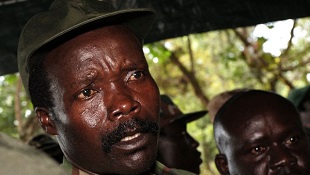
By Patrick Kamara
In our last episode, I described how in the early 2000s my then-editor at The Monitor newspaper, Ogen Kevin Aliro and his friend, then-Commander of the UPDF, Gen. James Kazini, flew me to cover the fight against Joseph kony’s Lord’s Resistance Army rebels in South Sudan. I described how we had flown here with a former LRA fighter who had been captured in battle.
We landed soon after a UPDF attack on a Kony camp at a place called Bin Rwot. David Ongia, the former LRA fighter, was about 20 years old and appeared to be mentally deranged. As soon as he hoped off the plane he started searching for his chicken in what used to be his hut, now smouldering in smoke. Whereas the UPDF thought David Ongia would give them valuable information on the terrain intelligence, I doubt he did.
The UPDF had burnt all the rebel huts including their stocks of food. Gardens were also destroyed. Kony had clearly been given a heavy blow.

David Ongia somehow managed to locate where Kony’s hut once stood. Outside it were several rounded white smooth stones gathered from the river. The kind of smooth stones found in fast moving rivers. The stones are shaped as a result of water hitting at them nonstop for thousands of years. They become smooth and beautiful. In my language these stones are called “enkulingo”
At Kony’s house in Bin Rwot the enkulingo had been placed in the compound and designed in the shape of a giant heart. In the middle of the heart shape were other small rounded stones forming a shape of a rosary.
We were told Kony would every morning kneel down in the heart-shape heart and pray. I remember when one journalist suggested that I demonstrate on camera how Kony used to do it by putting my knees exactly where the blood-thirsty rebel leader used to put his while performing his ritualistic prayers. I did it; moreover repeatedly to get the exact shot until someone warned that I was treading on dangerous ground. That I was risking getting possessed by LRA spirits. Any way nothing happened as I tried out several takes.
While we were there the UPDF discovered an armory several days later. Kony had hidden an assortment of guns and ammunition in pit latrines. Surprisingly these latrines were being used, first by the rebels and then the government forces after the fall of Bin Rwot. Talk about Kony hiding guns in plain sight. Other latrines were searched too am told including bases that Kony had abandoned for years.
In the evening I was given a machete to cut tree branches and make myself a tent where I would sleep. Shockingly, as soon as I cut the first tree, I had a barrage of gun fire coming from down the valley. The bullets were raining like a hailstorm.
After a short lull, I managed to run back to the main camp. From 6pm to seven that was the longest hour of my life as the fighting raged.
Because of superior weaponry, the UPDF prevailed and the attackers were repulsed. There was no sleeping that night because we knew the enemy was lurking in the bushes and could pounce once againanytime. That is the moment when you dread being a war correspondent. There is a moment when I almost asked for a gun because I did not want to die without a fight. Thank God sense and professional etiquettes prevailed.
It was not until 4pm the next day that Gen. Kazini landed back at Bin Rwot. It was the sight of his aircraft that possibly also gave our attackers a sense that perhaps the men they had fought the previous day were not their enemy, Kony’s LRA. Kony did not have planes.
Soon, they crawled out of the bush; walking in what the army calls“single file” (one column) and entered the UPDF defences in peace. Our attackers were a section of the Sudan Armed Forces (SAF) of theKhartoum government. Due to the uncoordinated nature of the troop movement, the SAF forces had mistaken the UPDF for LRA whom they had nick-named as Tong Tong.
The Sudanese army was not supposed to be hostile to their Ugandan counterparts. After all they had allowed UPDF to operate there and hunt Kony.
This was a friendly fire exchange and it had lasted more than an hour. Both sides thought they were fighting LRA. The Sudanese armed forces were ferocious in this attack because Kony had a week earlier killed several of their men including a major and a Lt. Colonel. The UPDF, on their side, could not afford to lose ground in this battle because it meant we would be annihilated in foreign territory. The stakes were extremely high.
The soldiers on both sides could not believe it that they had fought each other so ferociously the previous evening. Surprisingly in the so-called Arab force, there was not a single Arab save for one platoon commander who also looked of a mixed race.
For decades Khartoum would send African black soldiers to kill fellow blacks in the South. When all the SAF came out of the bushes, there appeared another problem. None of them could speak Swahili or any of the Sudanese languages in the South like Kuku, Shiluk,Nuer,Mundare, Dinka, or even Acholi. We later learnt that they were Darfurians from Western Sudan at the border with Chad. They were all speaking Arabic. Anyway they got some water and dry ration from their Ugandan counterparts and continued with the search of their own other enemy, the Sudan People’s Liberation Army of John Garang.
 The Independent Uganda: You get the Truth we Pay the Price
The Independent Uganda: You get the Truth we Pay the Price



